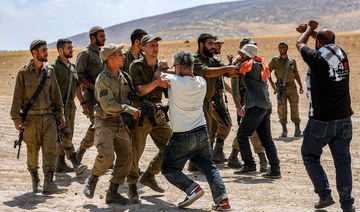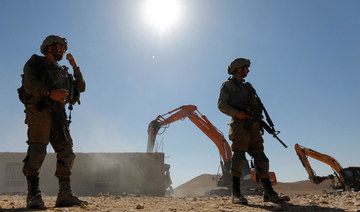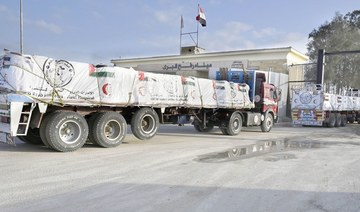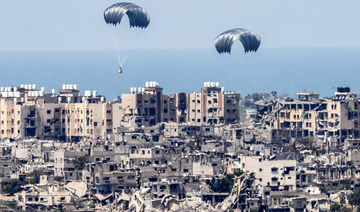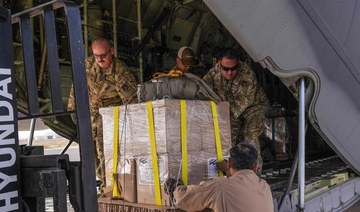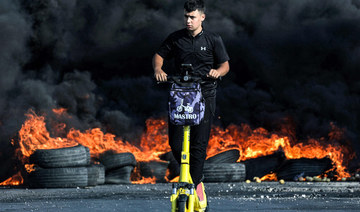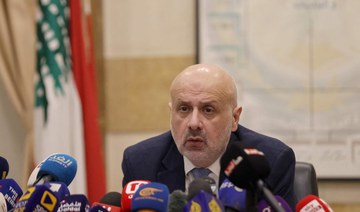JERUSALEM: Israeli forces killed a Palestinian in predawn clashes in the occupied West Bank city of Nablus on Thursday, Palestinian medics said. The Israeli army said he was armed and shooting at soldiers, something the Palestinians denied.
Witnesses said the clashes erupted when Israeli forces arrived to guard Jewish worshipers visiting Joseph’s Tomb, a Jewish shrine that has been a flashpoint in the Israeli-Palestinian conflict.
Four Palestinians were shot and one of them, an 18-year-old, was killed, the Palestine Red Crescent said. At least 30 Palestinians were wounded in all.
Later in the day, in a separate development, Israeli security forces raided seven non-governmental organizations in the West Bank, confiscating computers and equipment before sealing off the entrances, Palestinian witnesses and officials said.
This followed a decision by Israel to designate the groups as terrorist organizations, accusing them of funneling donor aid to Palestinian militants, a move that has drawn criticism from the United Nations and human rights watchdogs. The designation was ratified on Wednesday.
Nine European Union states have said they would continue working with the groups, citing a lack of evidence for the Israeli accusation.
Israeli Defense Minister Benny Gantz reiterated Israel’s position that the organizations had operated undercover to serve the Popular Front for the Liberation of Palestine (PFLP), which has carried out deadly attacks on Israelis and is on US and EU terrorism blacklists.
“They also assist in raising funds for the terrorist organization via a variety of methods that include forgery and fraud,” Gantz said.
Hussein Al-Sheikh, a senior official in the Palestinian Authority, said on Twitter that the “storming of civil work institutions ... is a dangerous escalation and is an attempt to silence the voice of truth and justice.”
“We will appeal to all official international bodies and human rights institutions to intervene immediately to condemn this occupier behavior and place pressure on them to reopen the institutions and to be able to exercise their activities freely,” Sheikh said.
Israeli forces kill Palestinian in West Bank clashes, medics say
https://arab.news/mbweh
Israeli forces kill Palestinian in West Bank clashes, medics say
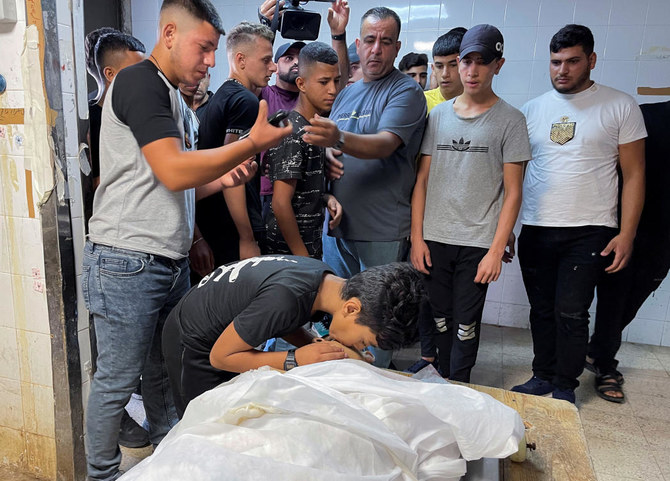
- Witnesses said the clashes erupted when Israeli forces arrived to guard Jewish worshipers visiting Joseph’s Tomb
- Palestine Red Crescent: Four Palestinians were shot and one of them was killed
Gaza’s 2m Palestinians now a population of ‘survivors,’ UN humanitarian chief says
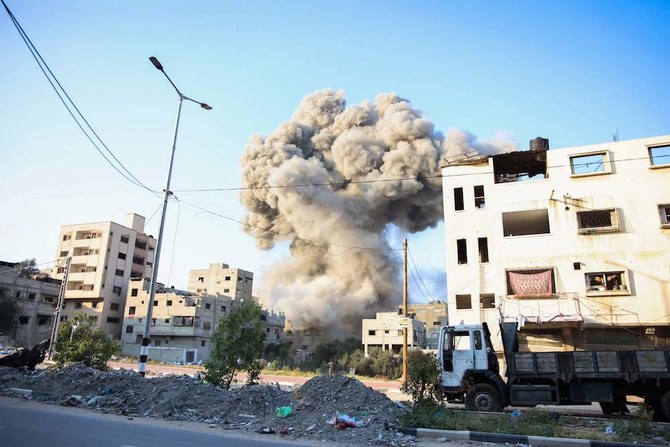
- Andrea De Domenico says the situation in the territory during Israel’s continuing war against Hamas is ‘dire, tense and very volatile’
- He warns it will ‘take years’ for Gaza’s 625,000 students to return to their studies as every university is destroyed and schools have been closed since the war began
LONDON: The 2 million Palestinians who live in the Gaza Strip can now be accurately described as a population of “survivors,” a UN humanitarian chief said on Tuesday.
Andrea De Domenico, head of the UN’s Office for the Coordination of Humanitarian Affairs operations in the Occupied Palestinian Territories, said the situation in Gaza during Israel’s continuing war against Hamas is “dire, tense and very volatile.”
The OCHA is “making all effort possible” to deliver aid to the territory, he added, but “the reality is that there is very little that we can bring to inside Gaza to tackle displacement and battle the looming famine.”
De Domenico said that if the widely predicted famine in Gaza comes to pass, it would be “completely man-made and preventable.”
He added that while there have been recent additional efforts by the UN, and by the Israelis “to some extent,” to increase the amount of aid entering northern Gaza, the worst-affected part of the territory, the situation would require a “massive operation” simply to reach the “minimum standard” of aid that is needed, which is something the OCHA is not in a position to mount at this time.
On Sunday, the agency said Israel “impeded or denied access” to 41 percent of UN-coordinated aid missions in northern Gaza between April 6 and 12.
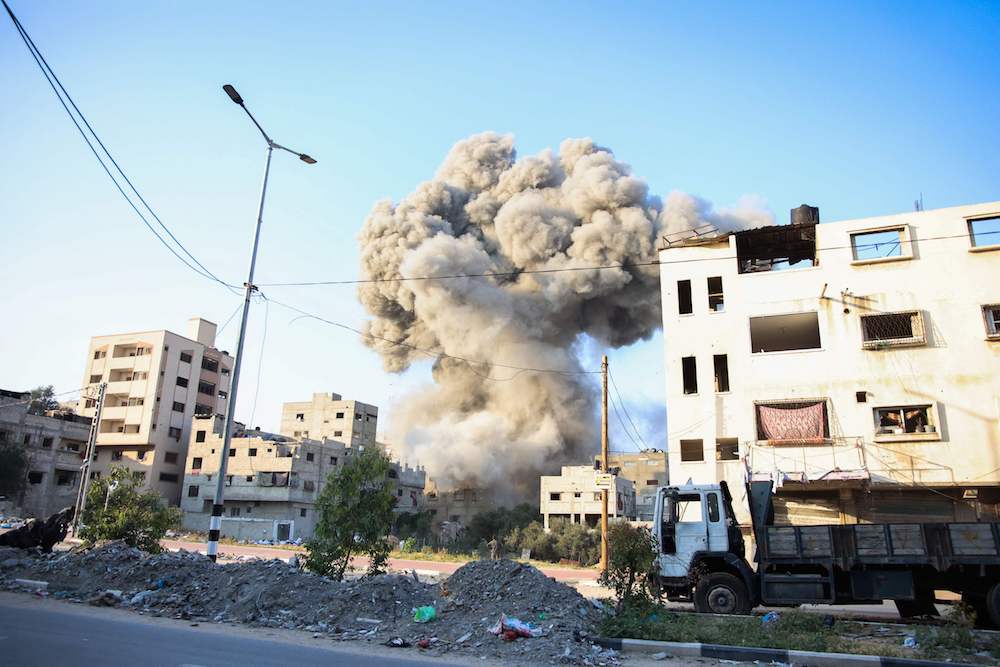
De Domenico also highlighted the “problematic situation” in and around hospitals in Gaza, especially at Al-Shifa where heavy fighting has caused widespread damage and destruction, which he said was proving to be another major obstacle to the delivery of aid and other relief supplies.
“Our team entered (Al-Shifa hospital) in the following days (after the fighting) and have had to deal with a scene of terror; the hospital is completely dysfunctional at this moment,” he said.
“The number of bodies that have been buried in or on the premises of Al-Shifa, or around the hospital, has also been problematic, to the point that UN and Palestinian colleagues have helped the families to start to recognize the remnants of the corpses.”
Also on Tuesday, it was revealed that relentless Israeli airstrikes have destroyed every university in Gaza. This, coupled with the fact that all schools in the territory have been closed since Israel launched its military offensive in October, means it will “take years” for the enclave’s 625,000 students to return to their studies, De Domenico said.
On Monday, the UN’s humanitarian coordinator for the Occupied Palestinian Territories, Jamie McGoldrick, said about 800,000 Palestinians might be forced to flee Gaza if the Israeli military goes ahead with a threatened ground incursion in the southern city of Rafah, close to the border with Egypt, which has become the final refuge for hundreds of thousands of people displaced by fighting in other parts of the territory.
He added that about 90 percent of approximately 4,000 buildings located along Gaza’s eastern border with Israel have been destroyed or damaged during the war, according to the UN Satellite Center.
Jordan completes six more airdrops of aid to northern Gaza
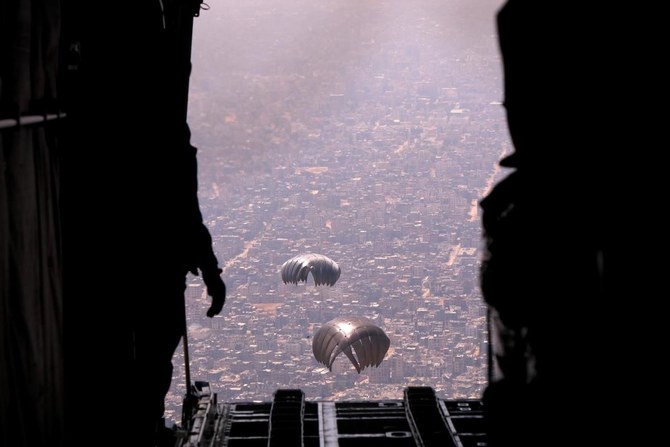
- Jordan has carried out 84 humanitarian airdrops independently, 190 in collaboration with other countries
AMMAN: Jordan’s armed forces completed another six airdrops of food aid to the northern Gaza Strip on Tuesday.
The humanitarian operation was carried out by the Royal Jordanian Air Force, using aircraft provided by Egypt, the US and Germany, the Jordan News Agency reported.
Since the start of Israel's war on Gaza in October, Jordan has completed 84 humanitarian airdrops of its own and 190 in collaboration with other countries.
During an interview with CNN in March, Queen Rania explained why authorities in the country had decided to take action to help people in an area the UN reports to be suffering from the effects of a widespread and severe food crisis.
“We found that after trying so hard in vain to persuade Israel to open the land-access points, we had to do something. We couldn’t just sit idle and watch people starving,” she said.
The airdrops are desperate measures to address a desperate situation, the queen added, describing them as mere “drops in an ocean of unmet needs.”
The Jordanian army said it remains committed to assisting efforts to deliver humanitarian aid to Gaza, in solidarity with the Palestinian people.
Emirati, British FMs discuss regional developments
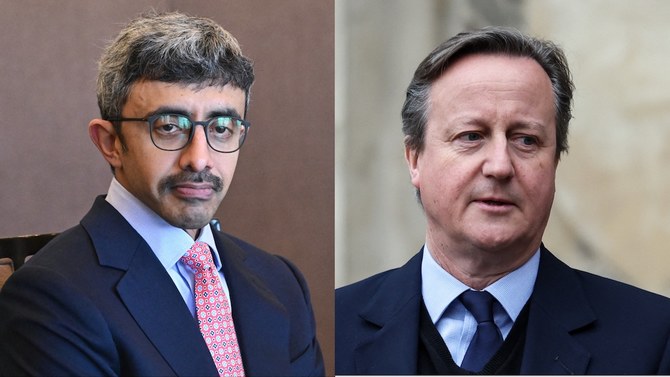
- Call followed Iran’s retaliatory drone and missile attack on Israel on Saturday
LONDON: Emirati Foreign Minister Sheikh Abdullah bin Zayed Al-Nahyan received a phone call from his British counterpart David Cameron regarding the latest regional developments and their impact on global peace and security, Emirates News Agency reported.
The two officials reviewed international efforts aimed at bolstering the response to the deepening humanitarian crisis in Gaza, emphasizing the need to expedite the delivery of safe and sustainable aid to the civilian population there.
The call followed Iran’s retaliatory drone and missile attack on Israel on Saturday.
The strike by more than 300 missiles and drones caused only modest damage in Israel as most were shot down by its Iron Dome defense system and with help from the US, Britain, France and Jordan.
Sheikh Abdullah highlighted the critical need for maximum restraint to prevent severe consequences and the potential escalation of instability in the region.
He underscored the importance of dialogue, diplomatic engagement, adherence to the rule of law, and respect for the UN Charter as vital means to resolve conflicts and enhance regional and global peace, stability, and prosperity.
Crimes by Syrians in Lebanon prompts debate over repatriations
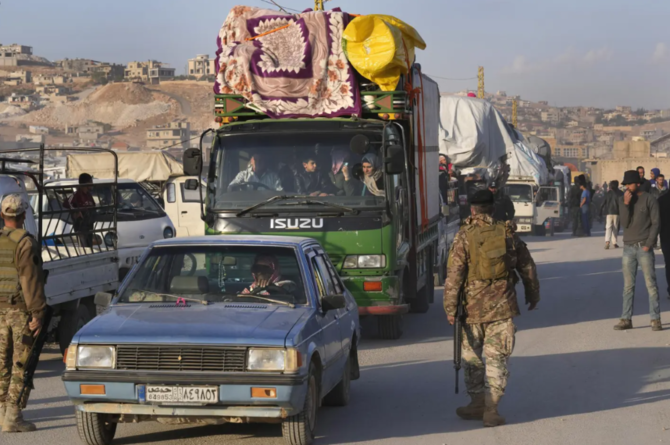
- Latest incident was the killing of an official in the Lebanese Forces Party, Pascal Suleiman
- Lebanon currently hosts around 2m Syrians, most having arrived since 2011
BEIRUT: The UN High Commissioner for Refugees reiterated on Tuesday “the right of Syrian refugees in Lebanon to return freely to their homeland whenever they choose to do so.”
It came as the campaign against the continued presence of Syrian refugees in Lebanon intensified against the backdrop of crimes committed by Syrians in recent weeks.
The latest incident was the killing of an official in the Lebanese Forces Party, Pascal Suleiman, last week after his car was stolen and his body taken to the Lebanese-Syrian border.
It was preceded a few days earlier by another crime committed in the Achrafieh area in Beirut against a husband and wife by their Syrian maid and other Syrians in an intended robbery. The husband died following the incident and his wife was seriously injured.
On Tuesday morning news broke of the death of Lebanese man Yasser Al-Kokash in the town of Al-Azzounieh in Aley district at the hands of Syrian citizens after they tied him up and stole the contents of his apartment.
Syrian refugees started coming to Lebanon in 2011. The number of refugees registered with the UNHCR has officially dropped to less than a million people after some subsequently returned to their country. However, after the UNHCR stopped registering Syrian refugees in 2015, the rate of illegal crossings from Syria to Lebanon increased.
Lebanon estimates the number of Syrian refugees on its territory to exceed 2 million people.
Caretaker Minister of Interior Bassam Mawlawi estimated the percentage of Syrian detainees and convicts in Lebanese prisons to be about 35 percent of the total prison population.
The Lebanese General Security has organized voluntary repatriation trips for Syrian refugees, but only a few thousand refugees have returned, as the Syrian regime decides who can according to lists of names provided by the Lebanese General Security to the relevant Syrian authorities.
In a statement, UNHCR spokeswoman Dalal Harb said: “We support and respect the humanitarian right of refugees to return freely and voluntarily to their home country, whenever they choose to do so, in accordance with international principles and non-refoulement.”
Harb stressed that “most Syrian refugees express their desire to return to Syria, but their decision is based on several factors, including safety, security, housing, access to basic services, and securing livelihoods.”
He added the UNHCR “will continue to cooperate with the General Directorate of General Security, which facilitates the repatriation of the refugees who want to return to Syria by registering their names.”
Ahead of the Brussels Conference on Refugees on April 30, Lebanon has urged donors to secure assistance to cover the cost of the Syrian presence in the country.
Minister of Information Ziad Makary said on Tuesday: “The illegal infiltration of Syrian refugees through the sea from Lebanon into Cyprus has caused a diplomatic crisis.
“The crimes that have occurred made us focus more on this existential problem for Lebanon. The solution is for them to either return to Syria or go to a third country.”
A plan proposed by the ministers of labor and social affairs, the Maronite League, and the General Directorate of General Security has also been addressed, which aims to repatriate Syrians and calls for the establishment of a National Emergency Authority headed by the prime minister.
It will be in charge of communicating with UNHCR officials in order to assist the state in classifying Syrians into three categories.
The first includes Syrians registered with the UNHCR as refugees and who can return to safe areas of their country. The second category includes Syrians who are registered with the UNHCR as refugees and work in Lebanon, while the third includes those who are registered with the UNHCR as refugees and want to travel to a third country.
As for the Syrians residing illegally in Lebanon, a “ministerial committee headed by the interior minister will be in charge of putting together lists of names indicating whether those Syrians have a valid residency or an expired one, and whether they have any documentation.”
The plan also stipulates that “land borders will be controlled, as it appeared that infiltration is mostly happening for economic reasons rather than security reasons.”
A delegation headed by Lebanese Forces MP Sethrida Geagea met Interior Minister Bassam Al-Mawlawi on Tuesday. Geagea called for “the implementation of the interior ministry’s circulars related to handling the illegal Syrian presence.”
Geagea estimated the number of Syrian refugees “in the northern Christian cities, Mount Lebanon and Jezzine to be around 830,000.”
She said that “implementing these circulars allow us to reduce the number of refugees very soon,” adding: “According to the United Nations, Lebanon is not a country of asylum, but a country of transit. We’ve been tolerating this since 2011, but we cannot do this anymore.”
Heavy rains lash UAE and surrounding nations as the death toll in Oman flooding rises to 18
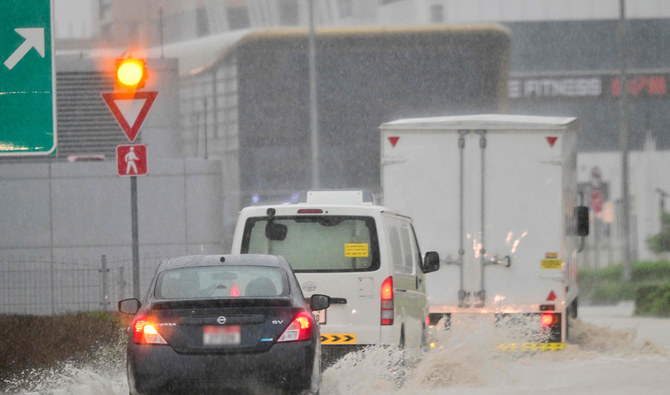
- Flights were canceled in Dubai while schools were shut in United Arab Emirates and Bahrain
- Some inland areas of the desert country recorded more than 80 millimeters (3.2 inches) of rain
DUBAI: Heavy rains lashed the United Arab Emirates on Tuesday, flooding out portions of major highways and leaving vehicles abandoned on roadways across Dubai. Meanwhile, the death toll in separate heavy flooding in neighboring Oman rose to 18 with others still missing as the sultanate prepared for the storm.
The rains began overnight, leaving massive ponds on streets as whipping winds disrupted flights at Dubai International Airport, the world’s busiest for international travel and the home of the long-haul carrier Emirates.
Police and emergency personnel drove slowly through the flooded streets, their emergency lights flashing across the darkened morning. Lightning flashed across the sky, occasionally touching the tip of the Burj Khalifa, the world’s tallest building.
Schools across the UAE, a federation of seven sheikhdoms, largely shut ahead of the storm and government employees were largely working remotely if able. Many workers stayed home as well, though some ventured out, with the unfortunate stalling out their vehicles in deeper-than-expected water covering some roads.
Authorities sent tanker trucks out into the streets and highways to pump away the water.
Rain is unusual in the UAE, an arid, Arabian Peninsula nation, but occurs periodically during the cooler winter months. Many roads and other areas lack drainage given the lack of regular rainfall, causing flooding.
Initial estimates suggested over 30 millimeters (1 inch) of rain fell over the morning in Dubai, with as much as 128 mm (5 inches) of rain expected throughout the day.
Rain also fell in Bahrain, Qatar and Saudi Arabia.
In neighboring Oman, a sultanate that rests on the eastern edge of the Arabian Peninsula, at least 18 people had been killed in heavy rains in recent days, according to a statement Tuesday from the country’s National Committee for Emergency Management. That includes some 10 schoolchildren swept away in a vehicle with an adult, which saw condolences come into the country from rulers across the region.



